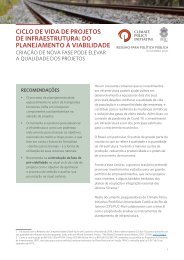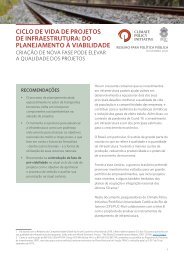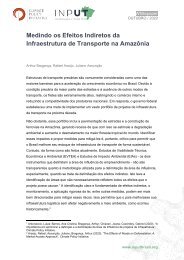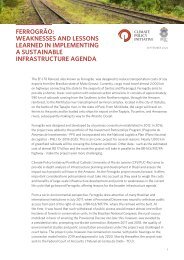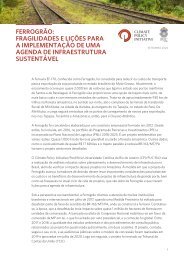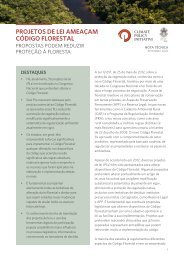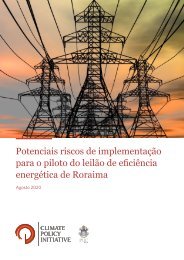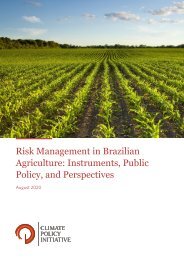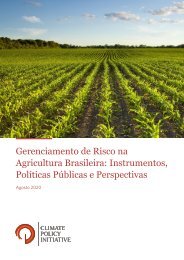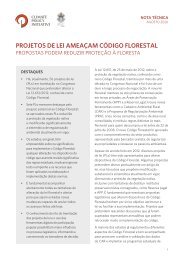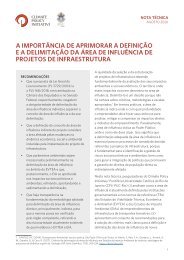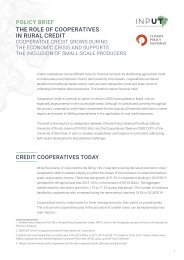The Need to Better Define and Delimit Area of Influence for Infrastructure Projects
Create successful ePaper yourself
Turn your PDF publications into a flip-book with our unique Google optimized e-Paper software.
<strong>and</strong> more direct identification. <strong>The</strong>se results show how the geography <strong>of</strong> the economic impacts<br />
resulting from the construction <strong>of</strong> EF-170 (Ferrogrão) is quite different from the geography <strong>of</strong> the<br />
project itself. This means that delimiting an area <strong>of</strong> influence simply by applying the ‘distance<br />
from the project’ criterion is unlikely <strong>to</strong> adequately cover the indirect impacts from the change<br />
in economic dynamics brought about by the project. In fact, the use <strong>of</strong> criteria exclusively based<br />
on distance from the project might overburden mitigation <strong>and</strong> compensation actions in the<br />
vicinity <strong>of</strong> the project, while disregarding these types <strong>of</strong> actions in areas farther away from the<br />
project but <strong>for</strong> which economic dynamics are nonetheless greatly affected by it.<br />
This underscores the need <strong>to</strong> establish clearer criteria <strong>for</strong> defining areas <strong>of</strong> influence. <strong>The</strong><br />
concept <strong>of</strong> area <strong>of</strong> influence must be extricated from its delimitation <strong>to</strong> enable a more reliable<br />
characterization <strong>of</strong> the area <strong>of</strong> influence <strong>for</strong> transport infrastructure projects. Especially in the<br />
area <strong>of</strong> indirect influence, it is also important <strong>to</strong> incorporate the influence <strong>of</strong> criteria related <strong>to</strong> the<br />
extent <strong>of</strong> the project’s economic impact in<strong>to</strong> the delimitation process.<br />
Figure 1: Change in the cost <strong>of</strong> transport <strong>to</strong> the port as a result <strong>of</strong> constructing EF-170 (Ferrogrão)<br />
Source: Climate Policy Initiative<br />
A concern with using these criteria is that projects could become even more complex. However,<br />
economic impact estimates are a key input <strong>for</strong> estimating the dem<strong>and</strong> <strong>for</strong> these projects <strong>and</strong>,<br />
as such, are an inherent part <strong>of</strong> a project’s design <strong>and</strong> feasibility studies. An example would<br />
be a road designed <strong>for</strong> a geographical area widely used by producers, who would experience<br />
a reduction in sourcing <strong>and</strong> marketing costs. This means that it is possible <strong>to</strong> use the same<br />
criteria used <strong>to</strong> identify the users <strong>of</strong> the project <strong>to</strong> also determine the locations where its socioenvironmental<br />
impacts are likely <strong>to</strong> occur <strong>and</strong> which may warrant actions by the project manager<br />
<strong>and</strong> the government <strong>to</strong> mitigate.<br />
<strong>The</strong> EF-170 (Ferrogrão) case is a good example <strong>of</strong> the relevance <strong>of</strong> the proposed criteria when<br />
assessing these projects from a cost-benefit st<strong>and</strong>point. <strong>The</strong> EVTEA <strong>for</strong> this project estimates<br />
6




